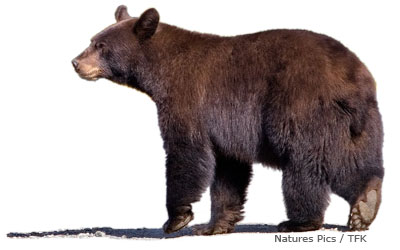
Home | About Us | Projects | Maps

Home | About Us | Projects | Maps
|
American Black Bear (Ursus americanus) Description: The American Black Bear is the most common bear native to North America. The coat of a Black Bear is shaggy and usually black but it can also be dark brown, cinnamon, yellow-brown, grey-blue and white depending on location. A white chest patch is uncommon in most populations. Eyes are brown (blue at birth). Skin is light gray. The black bear is approximately 4 to 7 feet from nose to tail, and two to three feet high at the withers. It has small eyes, rounded ears, a long brown snout, a large body, and a short tail. Males weigh an average of 150-300 lbs. 
Black bears with white-bluish fur are known as Kermode (glacier) bears and these unique color phases are only found in coastal British Columbia, Canada. It differs from grizzly bears in being smaller with a smaller shoulder hump, a furred rear instep, a less concave facial profile, smaller claws that are more tightly curved, and longer, smoother, and more tapered ears. Black Bears have strong powerful legs with large paws. They are expert tree climbers and have an excellent sense of smell. Range / Habitat: American Black Bears are found in the forested areas of Canada, USA and Mexico. Black bears have lost over 60% of their historical range. They historically occupied nearly all of the forested regions of North America, but in the U.S. they are now restricted to relatively undisturbed forested regions. Black bears are adaptable and live in a variety of habitat types. They are mainly found in forested areas with thick ground cover and an abundance of fruits, nuts and vegetation. In the north, they can be found in the tundra. They sometimes forage in fields or meadows. During the winter they hibernate in dens that they have built. They will build their dens in tree cavities, under rocks or logs, in banks or caves, culverts and in shallow depressions. Click on a range map to see where black bears live in Washington and California. Diet: American Black Bears are omnivores. 95% of their diet is plant based. American Black Bears mainly feed on vegetation including herbs, grasses, roots, buds, shoots, honey, nuts, fruit, berries and seeds. Occasionally they will also eat fish, small mammals, insects, carrion and garbage. In northern regions, black bears eat spawning salmon. They occasionally will kill young deer or moose calves. Behavior: Most bears become active a half-hour before sunrise, take a nap or two during the day, and bed down for the night an hour or two after sunset. Some bears are active mainly at night to avoid people or other bears. Black bears are considered highly efficient hibernators. They sleep for months without eating, drinking, urinating, or defecating. The length and depth of hibernation is genetically programmed to match the regional norms of food availability. Hibernation is deeper and can last over 7 months in the northern portion of the black bear range where abundant, high quality food is available only from May through August. In southern states where food is available year-round, some bears do not hibernate at all. Cubs usually stay with their mother for 17 months. One to six days before the mothers are ready to mate in late May or June, they force their yearlings to stop traveling along with them.
The video shows wild black bear cubs making blustery pounces followed by adults making the same displays. The cubs look cute
and the adults look scary, but their displays are equally harmless (North American Bear Center). 
Reproduction and Development: American Black Bears are solitary animals except for mothers with cubs, during the breeding season or when they come together at feeding sites. Black bears mate during the months of June and July. Cubs are born in January or February after a gestation period of 215 days. There are usually 2 - 3 cubs per litter, but litter sizes can be as large as 5. The cubs are born in a den while the mother is hibernating (sleeping during the winter). At birth the cubs weigh between 200 and 450 g (7 - 16 oz). They are born blind, with no fur and they will remain with their mother in the den until spring. The cubs are weaned at 6 - 8 months old. They usually stay with their mother for about 2 years so they can learn how to hunt and survive. They reach sexual maturity when they are between 2 and 5 years old. Life Span: American Black Bears can live to 30 years in the wild. They usually live for only about 10 years, due to encounters with humans. Other than humans, black bears have few predators — bobcats, cougars, and coyotes occasionally attack cubs. Did you know?
Animal silhouettes available to purchase » Photos: Nature's Pic's
Sources:
ADW: Ursus americanus: Information Black Bear Facts - WDFW - Living with Wildlife Black Bear Facts - North American Bear Center |